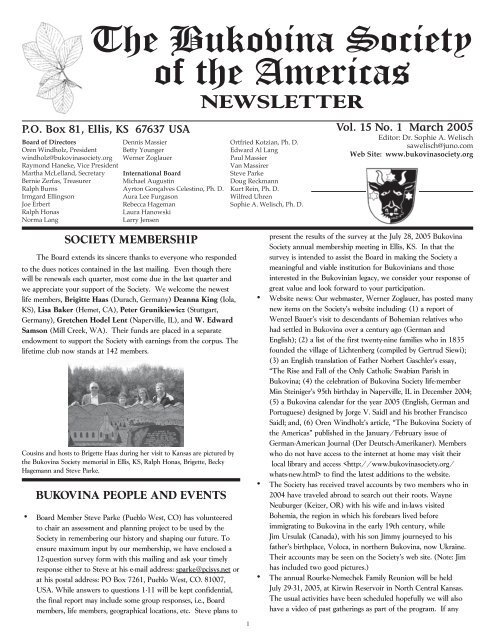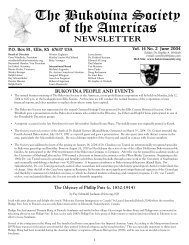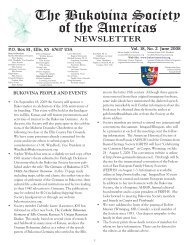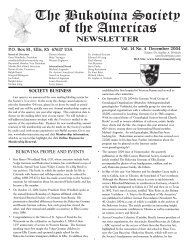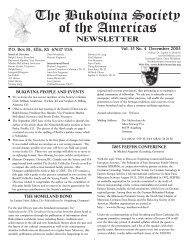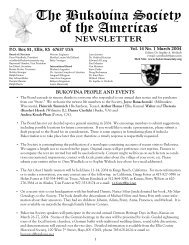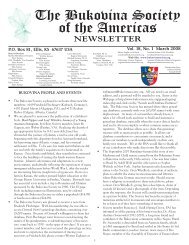Buko-NL-2005-1-Mar-Bukovina-Society-Newsletter
Buko-NL-2005-1-Mar-Bukovina-Society-Newsletter
Buko-NL-2005-1-Mar-Bukovina-Society-Newsletter
You also want an ePaper? Increase the reach of your titles
YUMPU automatically turns print PDFs into web optimized ePapers that Google loves.
Board of Directors<br />
Oren Windholz, President<br />
windholz@bukovinasociety.org<br />
Raymond Haneke, Vice President<br />
<strong>Mar</strong>tha McLelland, Secretary<br />
Bernie Zerfas, Treasurer<br />
Ralph Burns<br />
Irmgard Ellingson<br />
Joe Erbert<br />
Ralph Honas<br />
Norma Lang<br />
The <strong>Buko</strong>vina <strong>Society</strong><br />
of the Americas<br />
NEWSLETTER<br />
P.O. Box 81, Ellis, KS 67637 USA<br />
Dennis Massier<br />
Betty Younger<br />
Werner Zoglauer<br />
International Board<br />
Michael Augustin<br />
Ayrton Gonçalves Celestino, Ph. D.<br />
Aura Lee Furgason<br />
Rebecca Hageman<br />
Laura Hanowski<br />
Larry Jensen<br />
SOCIETY MEMBERSHIP<br />
The Board extends its sincere thanks to everyone who responded<br />
to the dues notices contained in the last mailing. Even though there<br />
will be renewals each quarter, most come due in the last quarter and<br />
we appreciate your support of the <strong>Society</strong>. We welcome the newest<br />
life members, Brigitte Haas (Durach, Germany) Deanna King (Iola,<br />
KS), Lisa Baker (Hemet, CA), Peter Grunikiewicz (Stuttgart,<br />
Germany), Gretchen Hodel Lent (Naperville, IL), and W. Edward<br />
Samson (Mill Creek, WA). Their funds are placed in a separate<br />
endowment to support the <strong>Society</strong> with earnings from the corpus. The<br />
lifetime club now stands at 142 members.<br />
Cousins and hosts to Brigette Haas during her visit to Kansas are pictured by<br />
the <strong>Buko</strong>vina <strong>Society</strong> memorial in Ellis, KS, Ralph Honas, Brigette, Becky<br />
Hagemann and Steve Parke.<br />
BUKOVINA PEOPLE AND EVENTS<br />
• Board Member Steve Parke (Pueblo West, CO) has volunteered<br />
to chair an assessment and planning project to be used by the<br />
<strong>Society</strong> in remembering our history and shaping our future. To<br />
ensure maximum input by our membership, we have enclosed a<br />
12-question survey form with this mailing and ask your timely<br />
response either to Steve at his e-mail address: sparke@pcisys.net or<br />
at his postal address: PO Box 7261, Pueblo West, CO. 81007,<br />
USA. While answers to questions 1-11 will be kept confidential,<br />
the final report may include some group responses, i.e., Board<br />
members, life members, geographical locations, etc. Steve plans to<br />
Ortfried Kotzian, Ph. D.<br />
Edward Al Lang<br />
Paul Massier<br />
Van Massirer<br />
Steve Parke<br />
Doug Reckmann<br />
Kurt Rein, Ph. D.<br />
Wilfred Uhren<br />
Sophie A. Welisch, Ph. D.<br />
1<br />
Vol. 15 No. 1 <strong>Mar</strong>ch <strong>2005</strong><br />
Editor: Dr. Sophie A. Welisch<br />
sawelisch@juno.com<br />
Web Site: www.bukovinasociety.org<br />
present the results of the survey at the July 28, <strong>2005</strong> <strong>Buko</strong>vina<br />
<strong>Society</strong> annual membership meeting in Ellis, KS. In that the<br />
survey is intended to assist the Board in making the <strong>Society</strong> a<br />
meaningful and viable institution for <strong>Buko</strong>vinians and those<br />
interested in the <strong>Buko</strong>vinian legacy, we consider your response of<br />
great value and look forward to your participation.<br />
• Website news: Our webmaster, Werner Zoglauer, has posted many<br />
new items on the <strong>Society</strong>’s website including: (1) a report of<br />
Wenzel Bauer’s visit to descendants of Bohemian relatives who<br />
had settled in <strong>Buko</strong>vina over a century ago (German and<br />
English); (2) a list of the first twenty-nine families who in 1835<br />
founded the village of Lichtenberg (compiled by Gertrud Siewi);<br />
(3) an English translation of Father Norbert Gaschler’s essay,<br />
“The Rise and Fall of the Only Catholic Swabian Parish in<br />
<strong>Buko</strong>vina; (4) the celebration of <strong>Buko</strong>vina <strong>Society</strong> life-member<br />
Min Steiniger’s 95th birthday in Naperville, IL in December 2004;<br />
(5) a <strong>Buko</strong>vina calendar for the year <strong>2005</strong> (English, German and<br />
Portuguese) designed by Jorge V. Saidl and his brother Francisco<br />
Saidl; and, (6) Oren Windholz’s article, “The <strong>Buko</strong>vina <strong>Society</strong> of<br />
the Americas” published in the January/February issue of<br />
German-American Journal (Der Deutsch-Amerikaner). Members<br />
who do not have access to the internet at home may visit their<br />
local library and access to find the latest additions to the website.<br />
• The <strong>Society</strong> has received travel accounts by two members who in<br />
2004 have traveled abroad to search out their roots. Wayne<br />
Neuburger (Keizer, OR) with his wife and in-laws visited<br />
Bohemia, the region in which his forebears lived before<br />
immigrating to <strong>Buko</strong>vina in the early 19th century, while<br />
Jim Ursulak (Canada), with his son Jimmy journeyed to his<br />
father’s birthplace, Voloca, in northern <strong>Buko</strong>vina, now Ukraine.<br />
Their accounts may be seen on the <strong>Society</strong>’s web site. (Note: Jim<br />
has included two good pictures.)<br />
• The annual Rourke-Nemechek Family Reunion will be held<br />
July 29-31, <strong>2005</strong>, at Kirwin Reservoir in North Central Kansas.<br />
The usual activities have been scheduled hopefully we will also<br />
have a video of past gatherings as part of the program. If any
elatives want more information, contact Steve Parke at<br />
sparke@pcisys.net.<br />
• Between November 19-21, 2004 International Board members<br />
Michael Augustin (Leonberg, Germany) and Dr. Ortfried Kotzian<br />
(Augsburg, Germany) presented papers at a conference in<br />
Reimlingen, Bavaria sponsored by the Haus des deutschen Ostens<br />
and attended by approximately seventy guests. The theme of the<br />
conference: “Cultural Traditions of Southern Bohemia.” Ortfried<br />
addressed aspects of the spiritual-cultural character of the Sudeten<br />
Germans, while Michael spoke of the Bohemian Foresters who in<br />
the early to mid-nineteenth century immigrated to <strong>Buko</strong>vina and<br />
later overseas, in particular to the United States.<br />
• Ortfried Kotzian, International Board member and Director of the<br />
Haus des Deutschen Ostens (Munich), has advised us of his<br />
recent publication: Die Umsiedler: Die Deutschen aus Bessarabien,<br />
der <strong>Buko</strong>wina, der Dobrudscha, Galizien, der Karpaten-Ukraine<br />
und West-Wolhynien. Studienbücher der Stiftung Ostdeutscher<br />
Kulturrat (Munich: Verlag Langen/Müller, 2004), 380 pp. This<br />
book may be obtained for 29.90 euros through www.amazon.de><br />
• Congratulations to Wilhelmina Hamann Steininger (Naperville,<br />
IL), born December 16, 1909 in Mitoka Dragomirna, who in early<br />
1910 immigrated to Naperville, Illinois. In December, she<br />
celebrated her 95th birthday. Wilhelmina has fond memories of<br />
her attendance at the early <strong>Buko</strong>vinafests in Ellis.<br />
• Thanks to Edward Al Lang (Sycamore, IL) for donating a<br />
generous supply of his books to the <strong>Society</strong> to sell at the museum<br />
and on the store page of the website.<br />
• The <strong>Society</strong> learned that Ruth Schmahl died at the home of her<br />
daughter Fay Jordaens in NetCong, NJ on January 18, <strong>2005</strong>.<br />
Born on September 15, 1906 at Edenwold, Saskatchewan, she<br />
married Friedrich Wilhelm Schmahl on April 21, 1926. Her<br />
husband died on May 1, 1991. Ruth was a life member of the<br />
<strong>Society</strong> and, along with Fay, contributed funds and artifacts to the<br />
museum and archives at the headquarters in Ellis, KS. Our<br />
sympathies are extended to Fay and her family.<br />
• An article entitled “The <strong>Buko</strong>vina <strong>Society</strong> of the Americas” by<br />
Oren Windholz, President of the <strong>Buko</strong>vina <strong>Society</strong>, was published<br />
in the January/February <strong>2005</strong> issue of German-American<br />
Journal (Der Deutsch-Amerikaner). Covering three full pages<br />
and numerous photographs, it details the history, objectives and<br />
activities of the <strong>Society</strong> since its founding in 1988.<br />
ARCHBISHOP ADAM EXNER AND HIS<br />
FAMILY TIES TO MOLODIA<br />
by Sophie A. Welisch (Congers, NY)<br />
The retirement in January 2004 of Archbishop Adam Exner, Arch-<br />
2<br />
bishop of Vancouver, British Columbia seems an appropriate time to<br />
reflect on the achievements of one of the <strong>Buko</strong>vinian community’s<br />
most distinguished sons and his family ties to Molodia.<br />
The second North American archbishop with <strong>Buko</strong>vinian roots (the<br />
first being Archbishop Josef Weber of Fürstenthal), the Most Reverend<br />
Adam Exner was born in Killaly, Saskatchewan on December 24,<br />
1928. His parents, Joseph Exner of Molodia and Frances née Gelowitz<br />
of Derelui immigrated to Canada as children (in 1898 and 1901<br />
respectively), homesteading with their families in <strong>Mar</strong>iahilf, a community<br />
inhabited mainly by <strong>Buko</strong>vinians. A population explosion coupled<br />
with a shortage of land had led to a great immigration from Molodia<br />
to Canada beginning in 1898, which lasted uninterruptedly until the<br />
First World War. This exodus resulted in the loss of at least 50<br />
percent of the village population in less than two decades.<br />
In Saskatchewan the first Molodia immigrants had founded the village<br />
of <strong>Mar</strong>iahilf, where most of their compatriots settled. There they<br />
remained true not only to their faith but until relatively recent times<br />
also to their “Swabianness.” Molodia had the distinction of being “the<br />
only Swabian Catholic Parish in <strong>Buko</strong>vina.” (See Norbert Gaschler,<br />
”Molodia: Eine schwäbisch-katholische Pfarrei in der <strong>Buko</strong>wina,”<br />
serialized in Der Südostdeutsche [Munich] beginning with the October<br />
15, 1982 issue). It is from this village, now incorporated in Ukraine<br />
and called Cosmin, that the Exner family had its roots. Aside from<br />
losing its name, Molodia has also lost its Swabian and Catholic<br />
character in the post-World War II era.<br />
Born into a farming family, Adam Exner worked on the family farm<br />
before attending St. Joseph’s College in Yorkton, Saskatchewan and<br />
later St. Thomas College in Battleford, Saskatchewan. He entered the<br />
Oblate Fathers in 1950 and made his novitiate at St. Norbert,<br />
Manitoba. Ordained into the priesthood in 1957, the Reverend Adam<br />
Exner served as teacher, rector/superior and lecturer in several<br />
religious institutions in Saskatchewan and Alberta before being named<br />
as Bishop of Kamloops, British Columbia. In <strong>Mar</strong>ch 12, 1974 he was<br />
consecrated in Regina, Saskatchewan in his home diocese. Bishop<br />
Exner took as his motto, “To serve as He served.” For his crest he<br />
chose a background of mountains superimposed with a sheaf of wheat<br />
incorporating a book, cross and staff, three symbols of Christ’s ministry<br />
passed on to the Apostles and their successors: the book for the teacher<br />
of the faith; the cross for life; and the staff for the pastoral (i.e., the<br />
shepherd’s) role as bishop of his flock. The mountains represent the<br />
British Columbian landscape of Archbishop Exner’s first diocese of<br />
Kamloops with the wheat identifying the Archbishop as a son of the<br />
prairies, who grew up on a farm and shared in its labors.<br />
Upon his elevation as Bishop of Kamloops, Der deutsche Katholik im<br />
Ausland (The German Catholic Abroad), Bonn, No. 6/1974 reported:<br />
“Regina/Canada, Pope Paul VI appointed Dr. Adam Exner, OMI,<br />
from a German family of Regina, as Bishop of Kamloops in British<br />
Columbia. . . . His parents emigrated from the former Austrian crown<br />
land of <strong>Buko</strong>vina . . . His 80-year-old mother was able to attend his<br />
consecration.” It adds that he is “the fourth Canadian bishop to come<br />
from a German-speaking family,” indicating that German was spoken<br />
in the Exner home. The Archbishop’s father, Josef A. Exner, born in<br />
Molodia in 1888, died on <strong>Mar</strong>ch 27, 1968 in Yorkton, Saskatchewan.
The installation of Adam Exner as fourth Archbishop of Winnipeg<br />
took place on June 23, 1982 at St. <strong>Mar</strong>y’s Cathedral in Winnipeg,<br />
Manitoba. In his capacity as Archbishop of Winnipeg, His Grace, the<br />
Most Reverend Adam Exner, served as one of the four Canadian<br />
delegates to the 1983 synod in Rome dealing with “Reconciliation,”<br />
chaired the Conference of Bishops of Manitoba, and was a member of<br />
the Episcopal Commission for Christian Education in Canada and of<br />
the Sacred Congregation for Bishops in Rome. On May 25, 1991 he<br />
was appointed Archbishop of Vancouver.<br />
The <strong>Buko</strong>vina <strong>Society</strong> takes pride in the Archbishop’s achievements<br />
and wishes him many healthy, happy and fruitful years in his retirement.<br />
A TRIP TO THE LAND<br />
OF OUR FATHERS<br />
by Wilhelm Fries, Ph. D. (Müllheim/Baden, Germany)<br />
On May 8, 2004 we departed for the trip to southern <strong>Buko</strong>vina in<br />
Romania, where our fathers had spent their childhood and youth until<br />
the 1940 resettlement. Our goal was the small village of Corlata<br />
(Korlata) in the vicinity of Ilisestie (Illischestie) on the eastern slopes<br />
of the Carpathians.<br />
Aside from myself, our travel group consisted of three people: my<br />
cousin Sieglinde, my cousin Bernd, and his wife Renate. Since my<br />
father had not been especially close to the family of his early-departed<br />
brother, I had not seen my cousins since childhood although we grew<br />
up in the same small city. We did not meet again until the funeral of<br />
my father in 2002. One year later we began planning a trip to<br />
<strong>Buko</strong>vina.<br />
We had only one single photograph from Corlata, which shows our<br />
fathers with their parents and a cow in front of their wooden house.<br />
The trip took at total of eight days. For the five days in Romania we<br />
had booked in advance with a travel bureau for a small bus with<br />
driver, a translator and all overnight accommodations with meals.<br />
We arrived there with our own auto. The route took us along the<br />
Danube through Vienna and Budapest. Often our thoughts centered<br />
on our forebears, who had traveled almost the same route along the<br />
Danube. From their homeland in the Rhineland they first immigrated<br />
to the former Austrian crown land of Galicia and then later to<br />
<strong>Buko</strong>vina, a distance of about 1500 kilometers.<br />
After an overnight stay in Hungary, we were greeted at the Romanian<br />
border by Dinu, our tour guide and translator, a young Romanian<br />
economics student. From the border to Bistrita in Transylvania, a<br />
distance of 280 kilometers, Dinu joined us in the car, which was not<br />
entirely comfortable.<br />
One of the first impressions in Romania was the wondrous beauty of<br />
the landscape. In Cluj (Klausenburg) in Transylvania we interrupted<br />
the journey for a brief city tour. The industrious construction activity<br />
made it obvious that we were in a land undergoing fundamental<br />
change. Above all many monuments from the Austrian period were<br />
just being renovated.<br />
On the entire trip the impressions of momentous historic changes in<br />
this section of Europe, which also played a role in the fate of our<br />
forebears as immigrants and settlers, were mirrored, indeed almost<br />
within our grasp.<br />
In the evening in the hotel in Bistrita at the reception with the tour<br />
directors, we tried to express our feelings. The Romanians, however,<br />
could not understand these sentiments, although at least in<br />
Transylvania all could still relate to the word “Saxons” (in<br />
Transylvania the German settlers were called “Saxons,” in <strong>Buko</strong>vina<br />
“Swabians,” although these terms did not necessarily have anything to<br />
do with their actual origins).<br />
After much discussion about bygone days and the German settlers, I<br />
eventually felt I should mention that we were not nationalists yearning<br />
for a restoration of the past and a presumed available “greatness” there.<br />
But that had not been necessary; the Romanians had not misunderstood.<br />
We parked our car in Bistrita and the next morning drove with a<br />
Volkswagen van across the Carpathians to <strong>Buko</strong>vina. Our travel group<br />
now consisted of Dinu (our translator), Viroel (the van driver) and us<br />
four visitors. On the trip across the Carpathians we stopped at the<br />
obligatory although not historic Hotel Dracula. The road was good up<br />
to that point. As it continued, however, it was in noticeably bad<br />
condition, so that for several hours we could proceed only very slowly.<br />
In Vatra Dornei (Dorna Watra), a resort on the Moldova River, we<br />
came upon a place at noon where I knew for the first time that my<br />
father had been. He had told of a pavilion in the park, where the resort<br />
had sponsored concerts.<br />
On the evening of our third day we reached Gura Humorului<br />
(Gurahumora). For the next three days we had accommodations in a<br />
private boarding house, where we lacked for nothing. The rooms had<br />
new furnishings (all of wood) and were very cheerful. We were<br />
catered to and overwhelmed with typical foods and drinks.<br />
On the fourth day of our trip we departed for Corlata, a distance of<br />
yet twenty kilometers, the last of which were traversed on unpaved<br />
roads. At last we began to believe that this is how we would actually<br />
find the village, which our fathers had abandoned sixty-three years<br />
earlier.<br />
And so it was. The typical and still widely-used horse-draw wagons<br />
drove up and down and streets. Below the village the farmland and the<br />
fields had the same dark, almost black earth about which my father<br />
had spoken. On the fields people still worked with horse, plow and ax,<br />
just as they had for many generations.<br />
In the village we first came upon the school, one of the few masonry<br />
buildings. Although instruction was in progress, they interrupted the<br />
session for us. It was a balmy spring day, yet the classrooms were still<br />
cold; the school was not heated so that the children had to wear caps.<br />
The students were already used to visitors from Germany, since Mrs.<br />
3
Johanna Jessen from Lohe-Rickelsof in north Germany, who had been<br />
born in Corlata, annually comes with her family in order to support<br />
the school and improve conditions for the children. More can be<br />
learned about Mrs. Jessen’s work for the children of Corlata from her<br />
web site: www.diekindervoncorlata.de<br />
There could no longer be a doubt that since the times of our fathers<br />
almost nothing had changed. Desks, wooden floors, doors, windows,<br />
pictures on the walls looked as though they had been there as long as<br />
the school had existed. Our fathers must have seen them exactly as we<br />
did now.<br />
After we had distributed our gifts, we proceeded to the center of the<br />
village. With the old photograph in hand I sought to identify the<br />
house of our forebears. Although we were not successful in recognizing<br />
“our” house, we did locate other original wooden houses from the<br />
Swabian period.<br />
The gravedigger was available to give us a perspective of the past. He<br />
told us that there was still a very elderly resident who perhaps could<br />
help us. But he was ill and a visit without the permission of the priest,<br />
for whom we then sent, was not possible. In the meantime the<br />
gravedigger guided us through the cemetery, showing us the extant<br />
gravestones of the settlers.<br />
To our great surprise we suddenly came upon a family gravestone. Up<br />
to this time we had not even considered this as a possibility. The<br />
inscription on the stone cross read: Here rests Christian Friess/ born<br />
15/9 1848/ died 8/2/ 1920/ Rest in peace<br />
After the trip I found among my research papers that this was our<br />
great great uncle, the oldest brother of our great grandfather, Heinrich<br />
Fries.<br />
Other names on the gravestones included Adam Schum, Johan Seibert,<br />
Anton and <strong>Mar</strong>ie Hassel.<br />
Soon the Orthodox priest arrived, a young man who owned the only<br />
auto in the village: a thirty-year-old Mercedes. He told us that aside<br />
from being the priest, he was also the village’s mayor and medical<br />
doctor. Unfortunately we could not visit the old man who might have<br />
been able to tell us about the past, since he was too ill.<br />
The priest showed us “his” Orthodox church, a stately new building,<br />
and invited us to come to his home. Like the school, the parish house<br />
was also of stone from the time of the Swabians. Although furnished<br />
simply but comfortably, it had evidently not been restored, since large<br />
fissures were visible in the masonry. His wife and three children<br />
greeted us and in the house we were served bread, sausage, apple wine<br />
and coffee. The priest’s foreign language was French, which we did not<br />
know. But thanks to our translator, we understood one another well.<br />
We learned that the winters were very harsh with temperatures under<br />
-20°C no rarity. Last winter the village was snowed in for three<br />
months and cut off from the outside world. Given the mild spring<br />
weather, this was difficult to envision.<br />
At the end of our stay in Corlata with the priest we ascended a hill in<br />
4<br />
back of his house and from there had a fascinating view. Here we<br />
gazed from the west over the village, which extended a long distance<br />
along a height lined with trees in the midst of a predominantly bare,<br />
steppe-like hilly landscape. We were at the last spurs of the<br />
Carpathians where a few kilometers further the hilly section ended<br />
and the landscape changed to seemingly endless rolling plains.<br />
We could recognize the Moldova Valley, where from the east the hills<br />
became ever smaller, eventually opening out into plains. Overwhelmed<br />
with impressions, we then returned to our boarding house.<br />
The following day our touring program included Carpathians,<br />
Moldavian monasteries, egg decoration, and pottery.<br />
On day six the time of our departure had arrived. We still had one last<br />
night in Bistrita and a great farewell with our Romanian escorts, who<br />
had become our friends in the days we had spent together.<br />
By the evening of day eight we were already at home with our<br />
families. The trip in the land of our fathers had transpired without<br />
difficulty. Our experiences still captivate us today, months later. One<br />
fact remains a certainty: we shall return.<br />
LUTHERAN LIFE IN BUKOVINA*<br />
by Ekkehart Lebouton<br />
With the exception of the Transylvanian Saxons, who throughout the<br />
centuries regularly appeared at the court of the Moldavian rulers and<br />
in some cases settled in Suczawa (Suceava) and Sereth (Siret) where<br />
they worked as craftsmen and merchants, one can date the beginning<br />
of a Protestant life in <strong>Buko</strong>vina only from the middle of the 18th<br />
century, when the castle steward of Cracow, Count Stanislaus<br />
Poniatowski, the father of the last Polish King, decided to establish a<br />
cloth factory on his estate in Zalesczyki on the Moldavian border along<br />
the Dniester River. With his declaration of intent, the count commissioned<br />
two Protestants, his Commissar General, the royal Polish<br />
Lieutenant Colonel von Oettykier, and the royal Polish Major von<br />
Koenigfels, who soon began construction of the factory on Polish<br />
territory and brought German artisans from Prussia, Warsaw, Elbing,<br />
Danzig and Thorn.<br />
A charter of July 1, 1759 from the Moldavian Prince Ioan Tudor<br />
provided the property for the construction of the first German<br />
Lutheran community in Phillippen (Philipce) opposite Zalesczyki (later<br />
Prelipcze). The establishment of the colony and a prayer house on land<br />
leased from property owner Manoli followed soon thereafter. The<br />
community, according to the princely patent, was to be directed by the<br />
eldest, known as “Capitain,” and was to chose from among their midst<br />
the assessors and church elders, who with Oettykier’s endorsement,<br />
turned to the Lutheran consistory in Breslau (Wroclaw) for a pastor.<br />
Such a one was found in the person of Johann Jakob Scheidemantel,<br />
born in Saxony-Gotha and ordained on September 10, 1760. A<br />
Protestant school for thirty children was soon built in Philipce.<br />
But the Phillippen community did not flourish and dissolved after the<br />
death of its patron Oettykier. While Scheidemantel accepted an<br />
invitation by the Danish embassy preacher to serve in Warsaw, the<br />
other villagers went further into Moldavia, where they were resettled
y Prince Ghika in Jassy (Iaºi) but primarily in the area of Czernowitz<br />
(Cernãuti).<br />
The annexation of <strong>Buko</strong>vina by Austria in 1775 ushered in a new<br />
chapter, marking the actual beginning of Protestantism in this<br />
territory. The appeal of the Emperor with the Patents of Settlement of<br />
October 1, 1774 and September 17, 1781 as well as the Patent of<br />
Toleration on October 12, 1781 drew a whole wave of immigrants,<br />
called “the great Swabian trek.” Among these “Swabians,” who were in<br />
fact mostly Palatines, there were numerous Lutherans. The settlement<br />
and composition of the communities proceeded not only according to<br />
territorial origins but also according to religious views, so that there<br />
arose both Catholic and Protestant Swabian farming communities. The<br />
Swabian farming communities were grouped in three centers:<br />
Czernowitz, Radautz-Milleschoutz (Rãdãuti), and Illischestie (Ilisesti).<br />
Considering the increasing number of Protestants—which by the end of<br />
1786 had reached 228 in Czernowitz and surroundings, Emperor<br />
Joseph II allowed that “a-Catholic” ministers visit their <strong>Buko</strong>vina coreligionists.<br />
Shortly thereafter (December 1, 1786) the government<br />
approved a salary of 30 florins for the “a-Catholic” preacher Himesch,<br />
a Transylvania Saxon, who was annually to undertake two to three<br />
visits to <strong>Buko</strong>vina.<br />
A decisive step followed in the spring of 1791 when the <strong>Buko</strong>vina<br />
Protestants received Stephan Hübel from Harburg in Württemberg as<br />
their own pastor with his seat in Milleschoutz near Radautz.<br />
On September 10, 1795 the Czernowitz community appointed Philipp<br />
Kern, the former pastor of Reichsheim, born in Ugartsthal (Galicia),<br />
who on January 20, 1797 was approved by the government as the first<br />
pastor of Czernowitz.<br />
The community of Milleschoutz-Radautz in time established the<br />
following affiliated communities: Alt-Fratautz (Frãtãutii Vechi),<br />
Arbora, Illischestie, Neu-Itzkany (Itcani Noui), Satulmare (Satul<br />
<strong>Mar</strong>e) and Tereblestie (Tereblecea-Neamt) in which first prayer<br />
houses and then churches with their own parsonages were built. With<br />
fruitful results the pastor Andreas Ephraim Schwarz (1754-1840) from<br />
Transylvania served there for decades. Under his successor, Pastor<br />
Johann Eduard Kerk, the incumbency was relocated to Radautz<br />
(decree of the Upper Church Council in Vienna of October 3, 1862).<br />
Czernowitz soon outgrew it mother community in Zalesczyki. Under<br />
the active leadership of Pastor Johann Gottlieb Jenkner from Dornfeld<br />
in Galicia the new church, the parsonage and the school were built.<br />
The city donated property in a good location and in 1849 Superintendent<br />
Haase was able to consecrate the new church. That same year<br />
witnessed the completion of the parsonage on the site where the old<br />
church had stood. In 1853 the new school under the direction of its<br />
first rector, Friedrich Mayer, born in Dornfeld (Galicia), was opened.<br />
This man and also his descendants contributed a number of significant<br />
community leaders.<br />
In 1862 Jenkner was put in charge of the eastern Galician superintendency,<br />
which then relocated from Ugartsthal to <strong>Buko</strong>vina and<br />
remained alternately between Czernowitz and Radautz until the end.<br />
With the new elections on August 25, 1878 Josef Fronius, at that time<br />
director of the girls’ high school in Mediasch, was unanimously<br />
5<br />
appointed for the position of parson. After him there followed a series<br />
of illustrious personalities in the Czernowitz pastorate. From twentyseven<br />
worshippers in 1786 and 400 in 1796, the community had<br />
grown to 1,628 after Fronius took over. By 1889 it had increased to<br />
almost 4,300 and by the outbreak of World War I stood at 6,833. By<br />
the time of the resettlement in 1940 the total again sank, leveling off<br />
at about 6000.<br />
Fronius first directed his attention to the school. The creation of a<br />
number of foundations for the maintenance of the church, the school,<br />
and the poor were due to his efforts. Above all in 1890 he also<br />
founded the ”Lutheran Gustav Adolf Ladies’ Association.” The<br />
Association was soon known through its regularly generous Christmas<br />
donations, which assuaged much need and suffering. But above all, his<br />
efforts were directed to the construction of an orphanage, which<br />
however, could only be built by Fronius’s successor.<br />
It was his task to organize the diaspora; the community of Czernowitz<br />
encompassed first five and then seven administrative districts over an<br />
area of about 5,000 square kilometers. The assumption of leadership of<br />
the superintendency presented an important task. Under his predecessors<br />
Jenkner in Czernowitz and Eduard Kerk in Radautz, six parish<br />
communities with sixteen affiliated communities could be established<br />
in which lived about 18,000 Protestants. Fronius left his successors<br />
eleven parish communities, eight preaching stations, forty-six religious<br />
instruction sites with a total of 23,830 worshippers. Fronius was<br />
elected senior pastor three times and led the superintendency for<br />
sixteen years. For thirty-two years he was also a member of the regional<br />
school council. Through membership in the “German School Association”<br />
he expressed his national orientation. In his endeavors Fronius<br />
was especially endorsed by the senior curator and regional parliamentary<br />
delegate Dr. Michael Kipper, as well as by the curator of the<br />
Czernowitz community, privy councillor Hans Mayer (son of the<br />
rector Franz Mayer).<br />
Radautz was the second-most important community and city in<br />
<strong>Buko</strong>vina. After Pastor Eduard Kerk, who since 1877 served as<br />
Jenkner’s senior successor and Fronius’ predecessor, there followed an<br />
imposing personality, namely <strong>Mar</strong>tin Decker, in 1889. Before Decker<br />
assumed office, the parish community extended over the entire central<br />
<strong>Buko</strong>vina and included 4,450 people. During Decker’s time in office,<br />
above all as senior pastor from 1911, church life experienced certain<br />
changes and developments. In 1891 the communities of Alt-Fratautz,<br />
Arbora, Badeutz-Milleschoutz, Satulmare and Tereblestie became<br />
affiliates.<br />
In south <strong>Buko</strong>vina we find the old Swabian farming community of<br />
Illischestie, the third center of Protestant life in <strong>Buko</strong>vina and with it<br />
the oldest Protestant community founded in 1789. At first a colony, it<br />
was only organized as a parish community in 1858 under Pastor Franz<br />
Samuel Traugott Gorgon in 1858. Friedrich Kipper was the founding<br />
curator. Number of parishioners: 2,900. The very old Swabian colony<br />
of Itzkany, which had already opened a Protestant elementary school<br />
in 1791, was affiliated with Illischestie. Under the curator Jakob<br />
Germann and the schoolmaster Jakob Serfass the community witnessed<br />
a great upswing in the mid-19th century. In 1913 under Pastor<br />
Hargesheimer we find in the vicinity of Illischestie the opening of a<br />
new preaching station in Gurahumora after Izkany with 1,484
worshippers became an independent community and the affiliated<br />
community of Mitoka-Dragomirna united with the preaching station of<br />
Suczawa. Their pastor since 1907 was Immanuel Friedrich Gorgon, the<br />
co-senior pastor of many years’ standing, whom with his long white<br />
beard, we still recall as a worthy patriarchal presence.<br />
With the immigration of the Zipser Saxons as lumbermen and miners<br />
there arose toward the end of the 18th century a center of Protestant<br />
life in Jakobeny, located in the lovely hilly region of forested <strong>Buko</strong>vina<br />
in the extreme southwest of the land. After these Zipser communities<br />
had for a time toward the end of the 18th century been affiliated with<br />
Milleschoutz or Radautz, Jakobeny with 3,099 communicants became<br />
an independent parish community in 1853. The long-term pastors of<br />
these congregations, who later also had a church and parsonage, were<br />
Frankendorfer and Schott.<br />
Illischestie und Jakobeny were the only purely mono-confessional<br />
Lutheran parishes in <strong>Buko</strong>wina. In all other parishes there were also<br />
branches of the Helvetian (Calvinist) denomination, but only those<br />
who belonged to the German ethnic group. The Hungarian parishes H.<br />
B. were independent and belonged to the parish community of<br />
Andràsfalva. With the outbreak of World War I there were in the<br />
eastern district of the Galician-<strong>Buko</strong>vinian superindendency of Biala<br />
and under the jurisdiction of Vienna the following: the Royal and<br />
Imperial Protestant Upper Church Council A. and H. B., eleven<br />
parishes, twenty-one affiliated parishes, nine preaching stations and<br />
sixteen schools with 25,698 congregants.<br />
From 1912 Vicar Glondys of Biala became pastor in Czernowitz in<br />
1912. His personal vicar, Max Weidauer, who later played a prominent<br />
role in the Zöckler institutions in Stanislau (Stanislav), was<br />
installed in Storozynetz. Glondys was without doubt the most significant<br />
personality, which the Lutheran church had brought forth in<br />
<strong>Buko</strong>vina as his later election as bishop of the Lutheran Regional<br />
Church A.B. in Romania confirms. He raised ecclesiastical, academic<br />
and musical life in Czernowitz to a height, which it had not previously<br />
witnessed before or after this time. It was he, who in the National<br />
Assembly in the archbishop’s residence, together with Dr. Alois<br />
Lebouton, in the name of the Germans declared support for the<br />
annexation of <strong>Buko</strong>vina with Romania. And it was also these two<br />
men, who led the union of the <strong>Buko</strong>vina superintendency with the<br />
Transylvanian regional church (1920).<br />
One year earlier Pastor Glondys was appointed municipal pastor in<br />
Kronstadt (Brasov).<br />
In 1927 the new church organization came into effect, in which the<br />
Protestant communities in <strong>Buko</strong>vina constituted an independent<br />
deaconate within the newly restructured “Protestant Regional Church<br />
A.B.”<br />
Pastor Decker was elected deacon with a newly elected district<br />
consistory as follows: as representative with the title senior pastor:<br />
Immanuel Gorgon; district church curator: Director Orest Buksch;<br />
district lawyer: senior administrative adviser Dr. Wilhelm Pompe.<br />
The new pastor Dr. Wilhelm Arz of Bistritz was installed according to<br />
the Transylvanian style on October 22, 1922. During his term of office<br />
the Protestant community of Czernowitz could continue its fruitful<br />
6<br />
development.<br />
In 1926 an orphanage was opened in Czernowitz. A new house for the<br />
teacher was built and the school could be expanded. Under the<br />
vigorous leadership of the imposing rector Ernst Mayer education took<br />
a great upswing. In 1927 the construction of a girls’ boarding school<br />
and high school were undertaken under the leadership of Dr. Adolf<br />
Butz. Between the church and parsonage a worthy memorial for the<br />
war dead was erected.<br />
Dean August Hargesheimer of Itzkany succeeded as senior pastor upon<br />
the death of Dean Decker and Pastor Fischer of Tereblestie replaced<br />
pastor Gorgon following the latter’s demise. In l931 Pastor Dr. Arz<br />
accepted a position as municipal pastor in Wittenberg. Until the<br />
election of a new pastor, Herbert Rückmann held the position of<br />
municipal preacher. His early passing prevented Dean Hargesheimer,<br />
the newly-elected pastor of Czernowitz, from assuming his office.<br />
He was succeeded by the Kronstadt Pastor Alfred Herrmann while the<br />
office of deacon passed to Pastor Edgar Müller in Storozynetz, which<br />
he held until the resettlement. Pastor Hans Rein of Radautz functioned<br />
as senior pastor.<br />
The occupation of <strong>Buko</strong>vina by the Russians in 1940 and the consequent<br />
resettlement with one stroke disrupted ecclesiastical Protestant<br />
life in <strong>Buko</strong>vina, which had been evolving for over two centuries.<br />
After the reconquest of <strong>Buko</strong>vina and Bessarabia through Romanian<br />
troops the author of this article was asked by the Regional Consistory<br />
in Hermannstadt (Sibiu) in late fall of 1941 to visit <strong>Buko</strong>vina and<br />
make contact with the still remaining vestiges of the Protestant<br />
communities and attempt to secure the Protestant ecclesiastical assets.<br />
What he found was dismal. The large beautiful communities of<br />
Tereblestie, Illischestie, Itzkany, and Eisenau were empty and desolate.<br />
Only in the cities could there still be found a number of solitary and<br />
broken co-religionists. Above all it was in Czernowitz where professors<br />
Klug, Salter and Naht held together the remnants of German life.<br />
In Kimpolung and environs a small gathering assembled around<br />
Administrative Advisor Kösseldorfer, and in Dorna-Watra and<br />
surroundings around school principal Hoffmann.<br />
On a second trip in 1942 approximately 300 persons could be<br />
identified as co-religionists scattered throughout the land. However,<br />
even these few surviving vestiges and any possible new initiatives were<br />
inevitably lost with the unfortunate course of the war.<br />
____<br />
*Ekkehart Lebouton, “Evangelisches Leben in der <strong>Buko</strong>wina”<br />
[Lutheran Life in <strong>Buko</strong>vina] in <strong>Buko</strong>wina: Heimat von Gestern, eds.<br />
Erwin Massier, Josef Talsky and B.C. Grigorowicz, trans. Sophie A.<br />
Welisch (Karlsruhe: Selbstverlag “Arbeitskreis <strong>Buko</strong>wina Heimatbuch,”<br />
1956), pp. 170-176.


